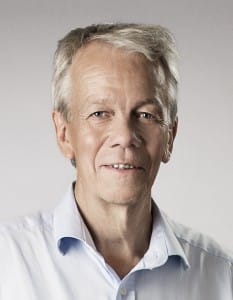Principle investigator at the prestigious Karolinska Institute in Stockholm, member of the Nobel Prize committee from 1995 to 2012, and one of the most renowned rheumatologists in the world, Lars Klareskog has an impressive track record. The Swedish scientist is a leading figure in rheumatology and has seen the field evolve drastically over the years.
“In the past 20 years, we have been very successful at understanding what happens in inflamed tissue,” explains Klareskog. “Various inflammatory cytokines have been discovered and antibodies developed to block them and the inflammation they cause. While these therapies were a tremendous improvement for many patients with various inflammatory diseases, they did not bring us closer to understanding how this inflammation originates. Now, perspectives on rheumatoid arthritis (RA) and other inflammatory diseases are evolving. We see that these types of diseases start with auto-immunity and continue with inflammation.”
Beyond symptomatic treatment
To further progress in rheumatology, Dr. Klareskog has been a vocal advocate for increased collaboration among various stakeholders. For many years, Klareskog’s academic group has collaborated with Janssen Pharmaceutica to combine their complementary expertise.
“To truly understand the course of the disease, we need to follow patients from very early on to late stages of the disease,” explains Anish Suri, Director at Janssen Immunosciences and a frequent collaborator with Klareskog. “This is not included in the activities of pharma and thus we must collaborate with the clinical sciences and gain access to patients. On the other hand, we provide the technology for drug development and knowledge about the pathways these drugs affect. As such, we create an iterative loop through which we keep learning from each other.”
Together with Janssen, Klareskog leads the IMI consortium RTCURE that seeks to move beyond symptomatic disease treatment and tackle the origin of disease: auto-immunity.
“In principle, it’s possible to re-regulate the immune system,” elaborates Klareskog. “We know that by vaccination, we can selectively increase immune defenses against various infectious agents. Conversely, the immune system harbors the same capacity to selectively downregulate immunity against particular antigens. If we learn enough about the particular immune reactions that cause auto-immunity, as we do for infections, then we can use the same tools available to us to stimulate immune defense against pathogens to reduce an immune overreaction. The ultimate goal is to specifically downregulate the immune cells that cause disease and as such induce tolerance to self-antigens.”
“Specificity is key if we want to achieve true disease interception,” adds Suri. “We can’t be carpet bombing if we want to intercept a disease before its clinical manifestations arise. We have to be more tailored the earlier we begin.”
Power to the patient
In addition to pharma, academia, and the clinical centers, the patient organizations and patients themselves play an important role in making the collaborative ecosystem of rheumatology work.
“We have set up systems on the clinical side to truly engage patients and explain why these efforts are important,” explains Klareskog. “What we have done very well in Sweden is set up a patient registry for rheumatoid arthritis patients. About 40,000 patients, which is nearly all the patients in our country, are included in this registry! This allows us to collect a wealth of data over long periods of time, including not only information relevant to research and drug development but also what the patients deem to be important, such as lifestyle improvements. In this way, both clinical practice and patient care can improve.
We are working on the idea that progress in our field has to be a community effort. We form lasting relationships and create trust among various organizations as we realize we are all working towards a common goal: the benefit of the patients.”
The Swedish registry for RA patients is a good example of this philosophy, as it creates a common ground for all stakeholders. While the government used to mandate that companies report on the safety and efficacy of their drugs, the registry now carries out this task. The industry thus has invested in an independent infrastructure that reports on drug safety, reassuring the patients that they are in good hands.
Thanks to a closer collaboration between clinical centers, academic groups, pharmaceutical companies and patient organizations, continued progress in rheumatology is assured!


